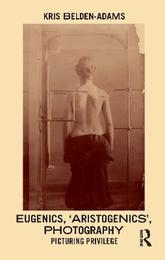
|
Eugenics, 'Aristogenics', Photography: Picturing Privilege
Hardback
Main Details
| Title |
Eugenics, 'Aristogenics', Photography: Picturing Privilege
|
| Authors and Contributors |
By (author) Kris Belden-Adams
|
| Physical Properties |
| Format:Hardback | | Pages:256 | | Dimensions(mm): Height 234,Width 156 |
|
| Category/Genre | The arts - general issues
Photography and photographs |
|---|
| ISBN/Barcode |
9781350132351
|
| Classifications | Dewey:778.926097444 |
|---|
| Audience | | Tertiary Education (US: College) | |
|---|
| Illustrations |
51 Illustrations, black and white
|
|
Publishing Details |
| Publisher |
Bloomsbury Publishing PLC
|
| Imprint |
Bloomsbury Visual Arts
|
| Publication Date |
25 June 2020 |
| Publication Country |
United Kingdom
|
Description
This is the first study to explore the connections between late-19th-century university/college composite class portraits and the field of eugenics - which first took hold in the United States at Harvard University. Eugenics, "Aristogenics," Photography takes a closer look at how composite portraiture documented an idealized "reality" of the New England social-caste experience and explains how, when positioned in relation to the individual stories and portraits of members of the class, the portraits reveal points of non-conformity and rebellion with their own rhetoric.
Author Biography
Kris Belden-Adams is Associate Professor of Art History at the University of Mississippi, USA.
Reviews"Belden-Adams shows us the importance of reflecting today on photography's construction of social privilege and investment in American nativism. Ascribing such work to college portraiture from the turn of the twentieth century, she reminds us that our photographic practices have always been political." -Tanya Sheehan, William R. Kenan Jr. Professor of Art, Colby College, USA "Belden-Adams's exceedingly well-researched book dives deep into the problematic waters of nineteenth-century eugenics photography and related uses of the medium. What she finds is that defining racial, criminal, and honorific types through photography held far more purchase in the US than previously known. But her study also shows that the instability of eugenics logic led to spectacular failures of the resulting pictures, particularly as compared to counter efforts at the subtle queering of photography at the same time among similar constituencies." -Andres Mario Zervigon, Professor of the History of Photography, Rutgers University, USA
|